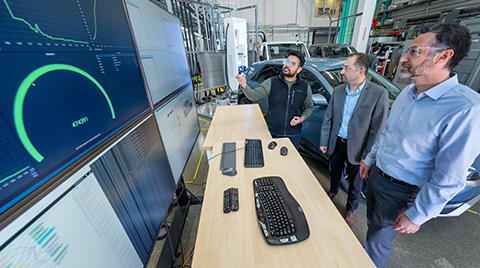Site-Integrated Electric Vehicle Charging
NLR evaluates various solutions for the site-level integration of electric vehicle (EV) charging for workplaces, multiunit dwellings, and commercial fleets.

Public and private charging infrastructure can increase convenience for drivers while offering new business opportunity for building owners and charging operators. Integrating buildings and EV charging requires a cohesive, holistic approach that considers building and other infrastructure loads to avoid increasing electricity costs from peak power loads and the need for extensive upgrades. Smart-charge management strategies can offer solutions.
Managed Workplace Electric Vehicle Charging and Building Energy Optimization
NLR investigates the cost-savings potential of managing workplace charging in accordance with optimizing real-time building loads. Tapping into operational data from NLR's charging station installations, researchers developed and validated two innovative systems for peak-load power curtailment: a workplace demand-charge-management system and a charge management performance control system.
Workplace-Demand Charge Management System
A workplace-demand charge-management system controls EV charging stations based on aggregated building loads.
Charge Management Performance Control System
A control system can improve charge-management performance using driver-provided information about energy needs and battery state-of-charge, in conjunction with a control algorithm to rectify inaccurate driver inputs when necessary.
Managed Charging With Site Load and Grid Considerations
NLR investigates charging scenarios to estimate the amount of energy required to charge EVs at large commercial buildings, such as offices and shopping centers, and develops charge-control strategies to optimize charging at these facilities.
NLR has unique research capabilities to de-risk scalable managed charging solutions using the Electric Vehicle Research Infrastructure and Commercial Buildings Research Infrastructure platforms. The electrical infrastructure at these facilities, which connects to several campus resources, enables small-scale experiments and prototypes to validate and refine managed charging strategies in a controlled environment before scaling up to real-world implementation.
Behind-the-Meter Energy Storage
NLR explores behind-the-meter storage technologies to help manage the demand-side aspects of EV grid integration. Such technologies could support the integration of EV high-power chargers, photovoltaic generation, stationary energy storage, building systems, and the electric grid. NLR’s state-of-the-art facilities evaluate how these technologies can integrate across transportation and building systems. Further, NLR’s world-class Advanced Research on Integrated Energy Systems research platform allows researchers to perform unmatched scale experiments, including necessary hardware, software, and controls validation, to de-risk and optimize EV charging infrastructure buildouts under real-world conditions.
Vehicle-to-Home Charging and Resilience
Using a bidirectional charger, EVs can be used to power homes or businesses. At a full charge, an EV could support an average home for several days as an emergency power source.
As a means of increasing resilience, NLR investigates vehicle-to-home charging strategies. NLR's vehicle-to-home charging research spans:
- Integrating emulated and real solar photovoltaic systems
- Conducting power measurements for various residential appliances
- Evaluating new power meters, sensors, and controls that can reduce the cost of submetering many circuits in a building
- Investigating the performance of home energy management systems, the impact of demand response programs on individual appliances, and the integration of behind-the-meter energy generation and energy storage with residential buildings.
Contact
Share
Last Updated Dec. 6, 2025
